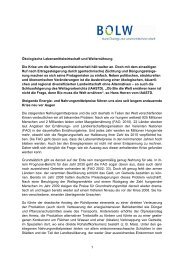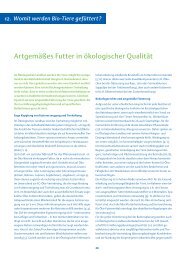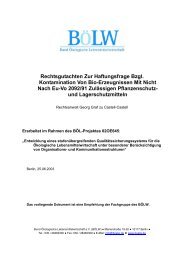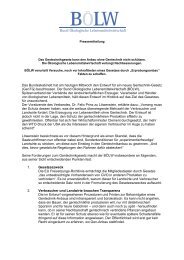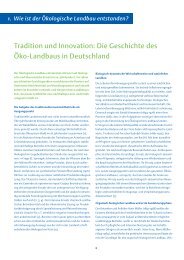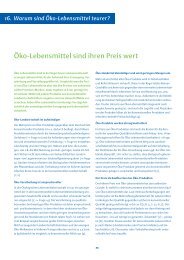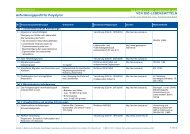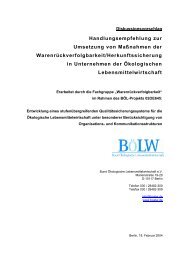Gutachten - Bund Ökologische Lebensmittelwirtschaft
Gutachten - Bund Ökologische Lebensmittelwirtschaft
Gutachten - Bund Ökologische Lebensmittelwirtschaft
Sie wollen auch ein ePaper? Erhöhen Sie die Reichweite Ihrer Titel.
YUMPU macht aus Druck-PDFs automatisch weboptimierte ePaper, die Google liebt.
Dr. U. Hofmann Kalium-Phosphonat<br />
könnten auf diese Weise beträchtliche Mengen Phosphit entstanden und in die Ozeane<br />
gelangt sein.<br />
„The interest of phosphite as a possible prebiotic phosphorous source is not only due to the<br />
higher solubility of its calcium-salt compared to apatite (approx. 1000 times higher), but also<br />
to its greater reactivity as a phosphorylating agent. It has been established that ammonium<br />
phosphate for example, readily reacts with nucleosides to yield nucleoside-phosphites<br />
(nucleoside-H-phosphonates) under conditions in which ammonium phosphate is unreactive”<br />
(Schwartz 2006).<br />
� Eine weitere natürliche Bildung reaktiver Phosphor-Verbindungen in der präbiotischen<br />
Urgeschichte der Erde (early earth) wird von Pasek (2008) beschrieben. Das<br />
außerterrestrische in Meteoriten gefundene Mineral Schreibersite (Fe,Ni)3P reagiert mit<br />
Wasser zu siderophilen P-Verbindungen. Diese reduzierten P-Verbindungen sind<br />
wesentlich löslicher und reaktiver als Orthophosphate.<br />
„The primary product of schreibersite oxidation by water is phosphite, HPO3 2- , with >50%<br />
of the total aqueous P in this form. A majority of these P compounds likely originate<br />
through free radical combination reactions” (Pasek 2008).<br />
“Phosphorous acid is considered to the plausible prebiotic source of phosphorous due to<br />
its hydrolytic production from the mineral schreibersite.” (Gulick 1955)<br />
De Graaf et al (1996), Pasek (2008), Schwartz (2006) belegen das Vorhandensein von<br />
reduzierten P-Verbindungen in „Ancient rocks, älter 2,5 Mrd. Jahre “ sowie in Meteoriten, der<br />
Carbonaceous chondrites 12 .<br />
Dabei konnten CaHPO3 sowie NaHHPO3 nachgewiesen werden. Allerdings sind die<br />
Phosphonate (Phosphite) sehr instabil und reagieren sehr schnell. Kalium-Phosphonat z.B.<br />
zerfällt in der Pflanze sehr rasch in das Kalium- sowie in das HPO3 2- -Ion, wobei das<br />
Phosphit-Ion als aktives Agens für die Auslösung der „Systemisch induzierten Resistenz“<br />
SIR verantwortlich ist. Das HPO3 2- -Ion ist sehr mobil und wird in der Pflanze sowohl im<br />
Phloem wie auch im Xylem transportiert.<br />
„The detection of small quantities of reduced P-oxides (eg. Phosphite and hypophosphate)<br />
or reduced C-P compounds in ancient sedimentory or metasedimentory rocks would provide<br />
strong evidence for reduced P in early Earth geochemistry” “The geochemistry of P on the<br />
early Earth is proposed to have included reduced P compounds in addition to phosphate”<br />
(Pasek 2008).<br />
12 Carbonaceous chondrites are grouped according to distinctive compositions thought to reflect the type of parent body from which they<br />
originated. These are named after a prominent meteorite — often the first to be discovered — in the group. Several groups of<br />
carbonaceous chondrites, notably the CM and Cl groups, contain high percentages (3% to 22%) of water, as well as organic compounds.<br />
They are composed mainly of silcates, oxides and sulfides, while the minerals olivine and serpentinite are characteristic. The presence of<br />
volatile organic chemicals and water indicates that they have not undergone significant heating (>200°C) since they formed, and their<br />
compositions are considered to be close to that of the solar nebula from which the solar system condensed. Other groups of C chondrites,<br />
e.g., CO, CV, and CK chondrites, are relatively poor in volatile compounds, and some of these have experienced significant heating on<br />
their parent asteroids. http://en.wikipedia.org/wiki/Carbonaceous_chondrite<br />
10



